Physical Address
304 North Cardinal St.
Dorchester Center, MA 02124
Ankle joint fusion/replacement
Arthroscopic procedures
Joint releases
Ligament repair
Tendon debridement, repairs and transfers
Osteotomies
Fracture care
Contracture releases
Böhm has described the developmental phases of the foot. At stage one (second month) of development the foot is in 90° equinus and is adducted; at stage two (beginning of the third month) the foot is in 90° equinus, adducted and markedly supinated; at stage three (middle of the third month) the foot is dorsiflexed at the ankle but a mild degree of equinus is still present, marked supination persists and the first metatarsal remains adducted; at stage four (beginning of the fourth month) the foot pronates and reaches a position of mid-supination, a slight metatarsal varus remains but there is no equinus.
Tibialis anterior presents a fusiform enlargement at the lateral side of the tibia and projects beyond the anterior border of this bone; its tendon can be traced on the front of the tibia and ankle joint, and thence along the medial side of the foot to the base of the first metatarsal. The fleshy fibres of fibularis (peroneus) longus are strongly marked at the upper part of the lateral side of the leg; the muscle is separated by furrows from extensor digitorum longus (anterior) and soleus (posterior). Inferiorly, the fleshy fibres end abruptly in a tendon that overlaps the more flattened elevation of fibularis brevis; below the lateral malleolus, the tendon of fibularis brevis is the more marked. The anterior tibial artery becomes superficial and can be traced over the ankle as it becomes the dorsalis pedis artery, which can then be followed to the proximal end of the first intermetatarsal space. The pulsation of the posterior tibial artery becomes evident near the lower end of the posterior aspect of the tibia, and is easily detected behind the medial malleolus ( Fig. 85.1 ).
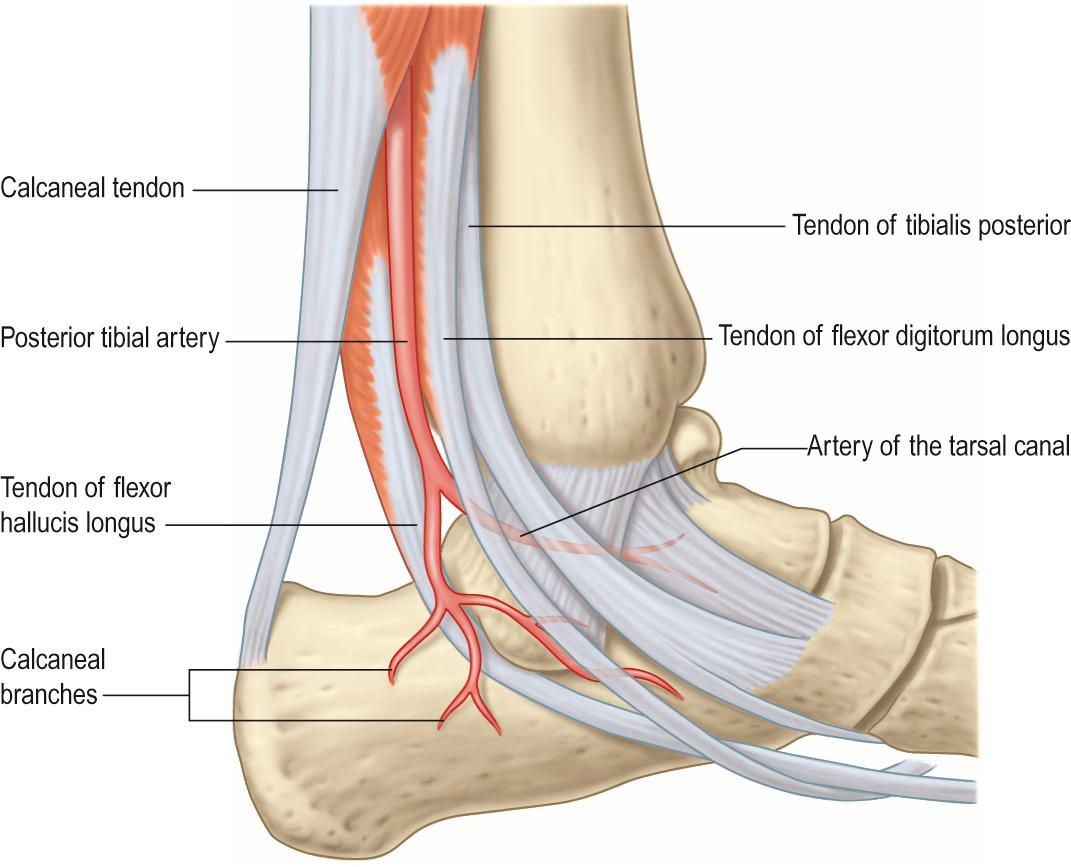
The so-called soft spots of the ankle are areas that can be palpated easily; they can be used during clinical examination to identify the margins of the joint and during arthroscopy to identify arthroscopic portal sites. The anterior medial soft spot lies between the medial malleolus and tibialis anterior. The anterior lateral soft spot is lateral to extensor hallucis longus and medial to the fibula. The posterior medial soft spot is located posterior to tibialis posterior at the junction of the talus, medial malleolus and tibia. The posterior lateral soft spot is found behind the lateral malleolus and tendons of fibularis longus and brevis, and anterior to the calcaneal (Achilles) tendon.
The ankle (talocrural joint) is a hinge joint and is approximately uniaxial. The distal end of the tibia, including the medial malleolus, together with the lateral malleolus of the fibula and the transverse tibiofibular ligament, form a deep recess (‘mortise’) for the body of the talus ( Fig. 85.2 ). The capsule of the joint fits closely around its articular surfaces; as in every hinge joint, it is weak anteriorly and posteriorly but reinforced laterally and medially by collateral ligaments. Although the ankle appears to be a simple hinge joint, its axis of rotation is dynamic, shifting during dorsiflexion and plantar flexion. Dorsiflexion results in the joint adopting the ‘close-packed’ position, with maximal congruence and ligamentous tension; all major thrusting movements, in walking, running and jumping, are exerted from this position. The body of the talus is slightly wider anteriorly ( Fig. 85.3 ); it becomes firmly wedged between the malleoli in full extension, whereas there is slight laxity at the joint and some degree of side-to-side tilting is possible in flexion, although no appreciable lateral movement can occur without stretch of the inferior tibiofibular syndesmosis.
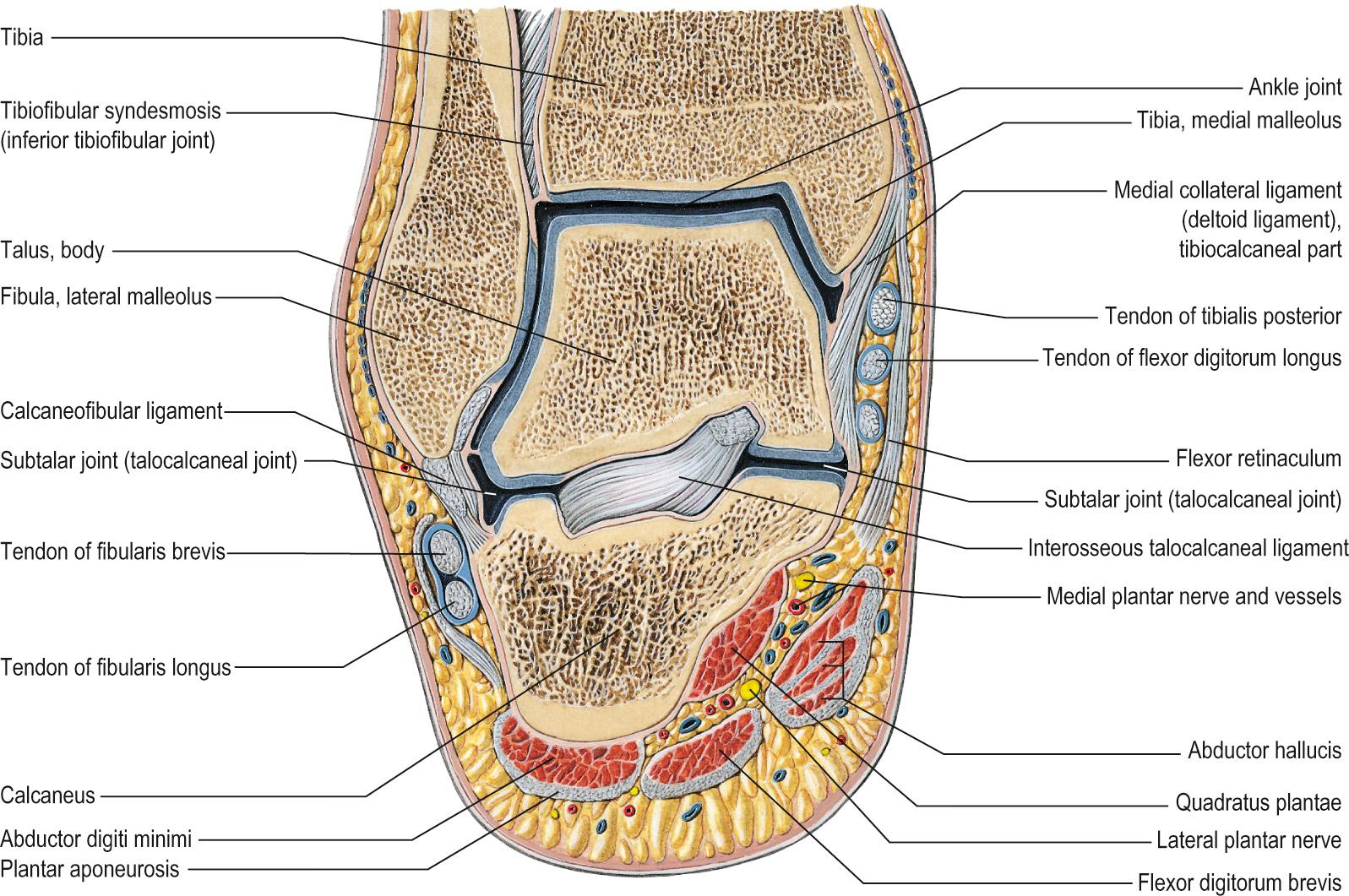
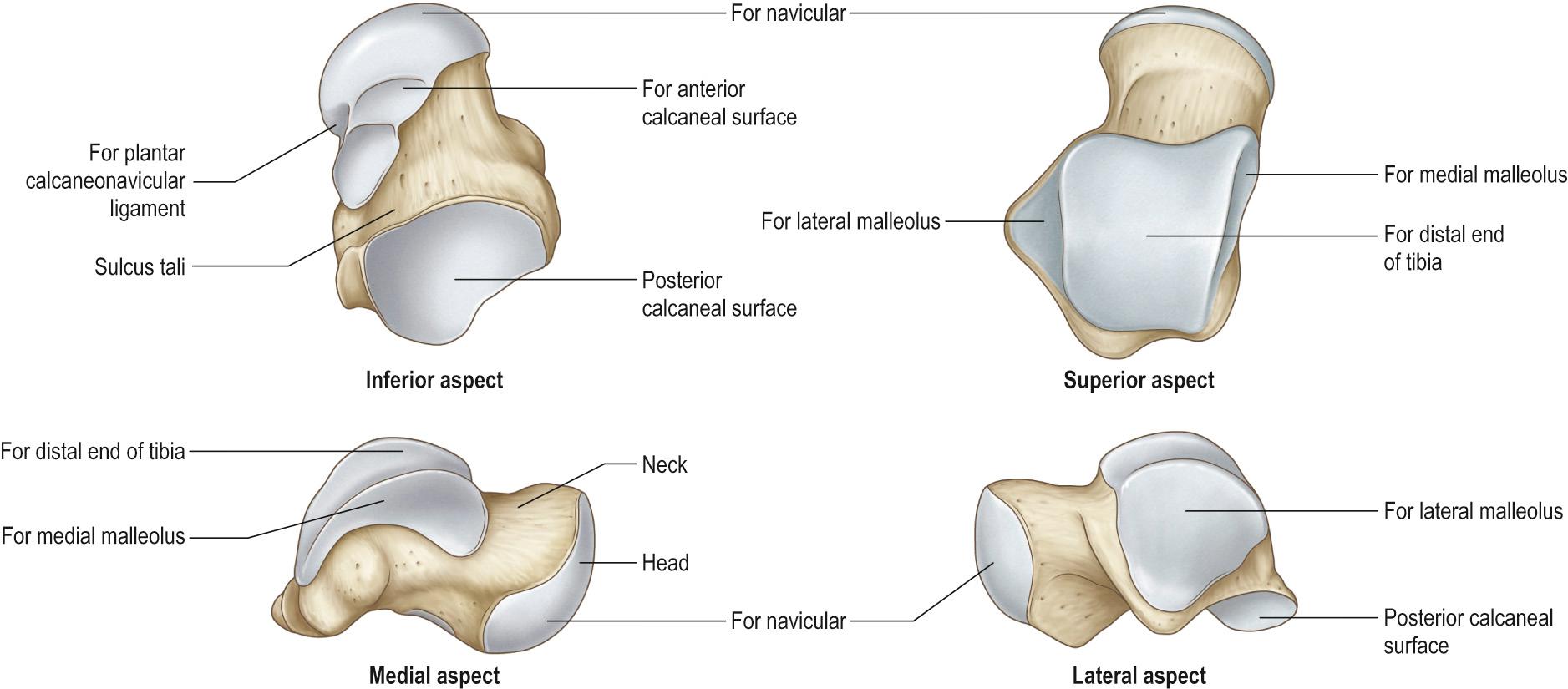
The ligaments of the ankle joint are the medial and lateral collateral ligaments ( ![]() ). The deltoid (medial collateral) ligament is divided into superficial and deep portions ( Fig. 85.4 ). The superficial portion arises from the whole extent of the medial malleolus, while the deep has two distinct bands – superficial and deep. The superficial band is composed of a tibionavicular part that arises from the anterior aspect of the medial malleolus and inserts into the navicular; a tibiospring part that rises from the medial malleolus and inserts into the plantar calcaneonavicular ligament (spring ligament); a tibiocalcaneal part that arises from the medial malleolus and inserts into the sustentaculum tali; and a posterior superficial tibiotalar part. The deep band is composed of anterior and posterior parts. The deep anterior tibiotalar part inserts into the non-articular part of the medial talus and is continuous with the medial portion of the interosseous talocalcaneal ligament. The deep posterior tibiotalar part runs between the posterior side of the medial malleolus and the medial side of the talus.
). The deltoid (medial collateral) ligament is divided into superficial and deep portions ( Fig. 85.4 ). The superficial portion arises from the whole extent of the medial malleolus, while the deep has two distinct bands – superficial and deep. The superficial band is composed of a tibionavicular part that arises from the anterior aspect of the medial malleolus and inserts into the navicular; a tibiospring part that rises from the medial malleolus and inserts into the plantar calcaneonavicular ligament (spring ligament); a tibiocalcaneal part that arises from the medial malleolus and inserts into the sustentaculum tali; and a posterior superficial tibiotalar part. The deep band is composed of anterior and posterior parts. The deep anterior tibiotalar part inserts into the non-articular part of the medial talus and is continuous with the medial portion of the interosseous talocalcaneal ligament. The deep posterior tibiotalar part runs between the posterior side of the medial malleolus and the medial side of the talus.
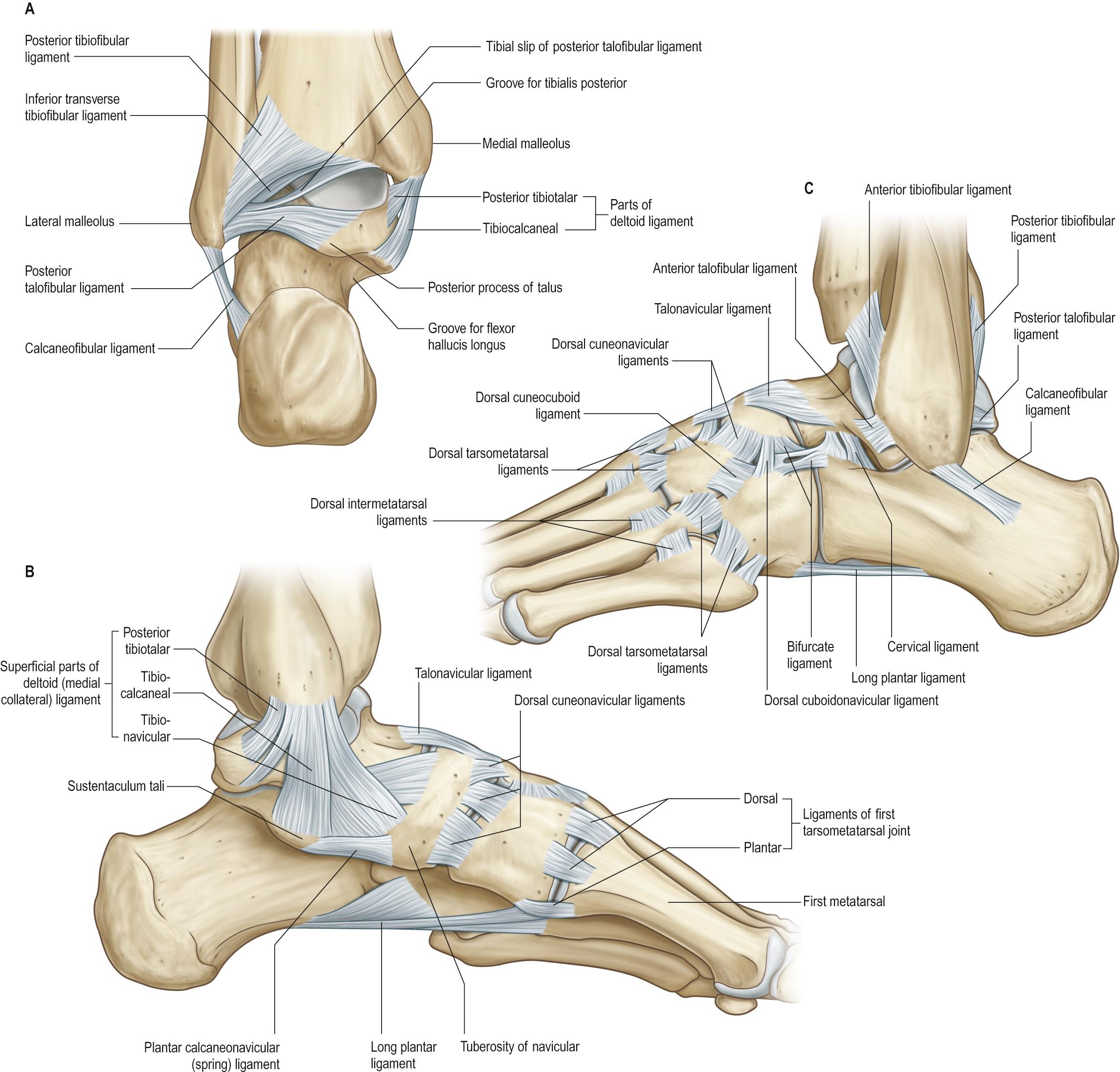
The plantar calcaneonavicular ligament is composed of three parts: the superomedial and inferior calcaneonavicular ligaments and the inferior plantar oblique ligament. The anterior tibiofibular ligament travels from the anterolateral surface of the distal tibia (Chopart's tubercle) to the fibula, passing inferiorly as it goes laterally, and the posterior tibiofibular ligament connects the posterior aspect of the medial malleolus to the back of the fibula; both ligaments can be seen during ankle arthroscopy.
The lateral collateral ligament is composed of the anterior talofibular ligament, which arises from the anterior aspect of the fibula and inserts into the junction of the neck and body of the talus; the calcaneofibular ligament, which courses anterosuperiorly to posteroinferiorly as it arises from the tip of the lateral malleolus and inserts into the lateral aspect of the calcaneus; and the posterior talofibular ligament, which is a thick horizontal band passing from the posterior aspect of the fibula to the lateral side of the posterior process of the talus.
Near the ankle joint, the tendons of the muscles of the leg are bound down by localized, band-shaped thickenings of the deep fascia termed retinacula, which collectively serve to prevent bowstringing of the underlying tendons during muscle contraction. There are superior and inferior extensor retinacula, superior and inferior fibular retinacula, and a flexor retinaculum.
The superior extensor retinaculum is attached laterally to the distal end of the anterior border of the fibula and medially to the anterior border of the tibia. It is wider (approximately 3 cm) medially and narrower (1.5 cm) laterally, and binds down the tendons of tibialis anterior, extensor hallucis longus, extensor digitorum longus and fibularis tertius immediately proximal to the anterior aspect of the ankle joint ( Fig. 85.5 ). The anterior tibial vessels and deep fibular nerve pass deep to the superior extensor retinaculum, and the superficial fibular nerve passes superficially. Its proximal border is continuous with the crural fascia, and dense connective tissue connects its distal border to the inferior extensor retinaculum. It blends laterally with the superior fibular retinaculum and medially with the upper border of the inferior extensor retinaculum. The tendon of tibialis anterior is the only extensor tendon that possesses a synovial sheath at the level of the superior extensor retinaculum. A band runs from the retinaculum to the anterior surface of the tibia, separating tibialis anterior from extensor hallucis longus. The inferior extensor retinaculum is a Y-shaped band lying anterior to the ankle joint (see Fig. 85.5 ). The stem of the Y is located laterally, where it is attached to the anterosuperior surface of the calcaneus, anterior to the calcaneal sulcus. The band passes medially, forming a strong loop around the tendons of fibularis (peroneus) tertius and extensor digitorum longus ( Fig. 85.6 ). From the deep surface of the loop, a band passes laterally behind the talocalcaneal interosseous ligament and is attached to the calcaneal sulcus. At the medial end of the loop, two diverging limbs extend medially to complete the Y-shape of the retinaculum. The proximal limb consists of superficial and deep layers. The superficial layer crosses the tendon of extensor hallucis longus and then adheres firmly to the deep one; in some cases, it continues superficial to the tendon of tibialis anterior, before blending with the deep layer. The deep layer passes deep to the tendons of extensor hallucis longus and tibialis anterior, but superficial to the anterior tibial vessels and deep fibular nerve, to reach the medial malleolus. The distal limb extends downwards and medially, and blends with the plantar aponeurosis; it is superficial to the tendons of extensor hallucis longus and tibialis anterior, the dorsalis pedis artery and the terminal branches of the deep fibular nerve.
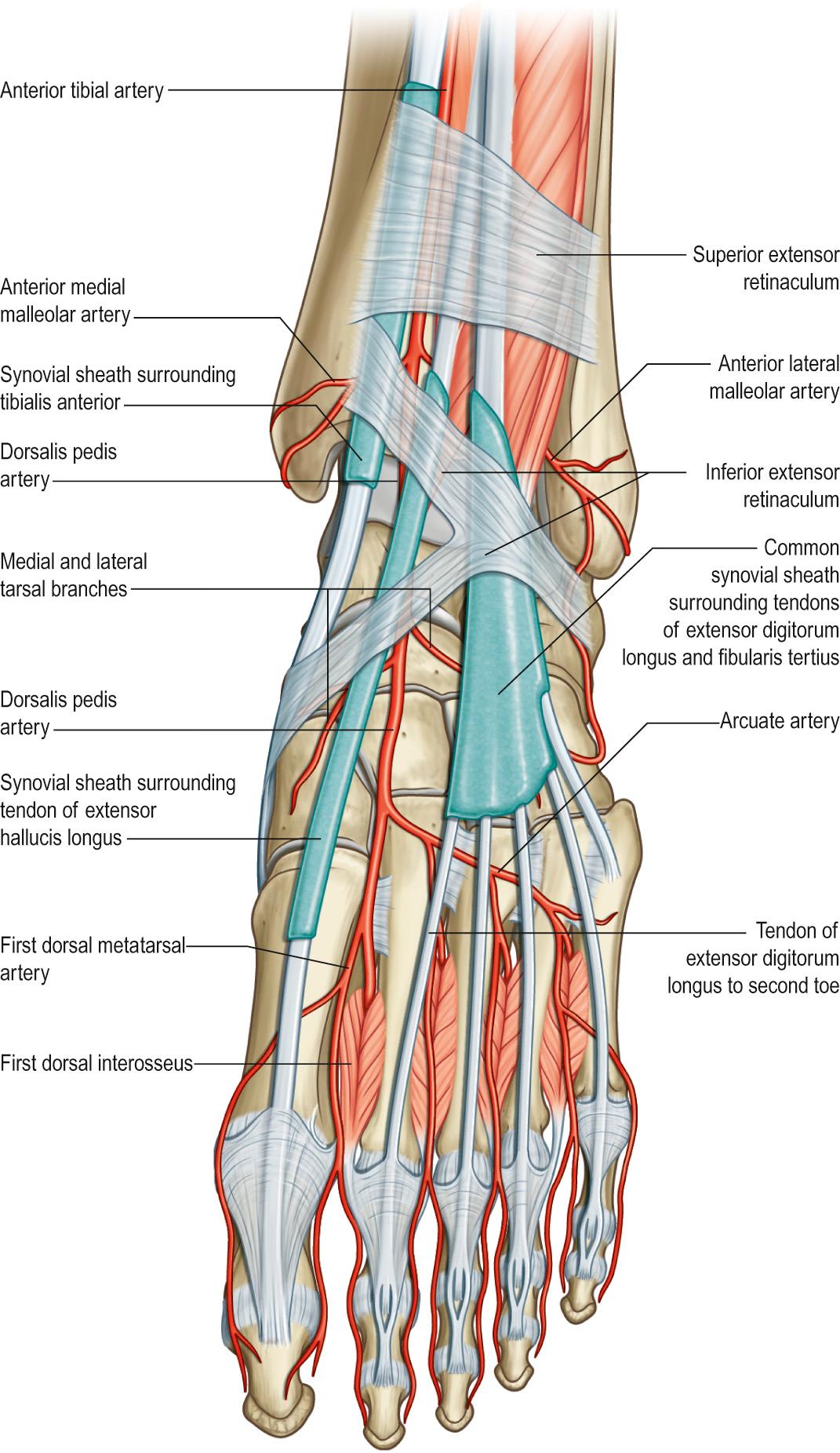
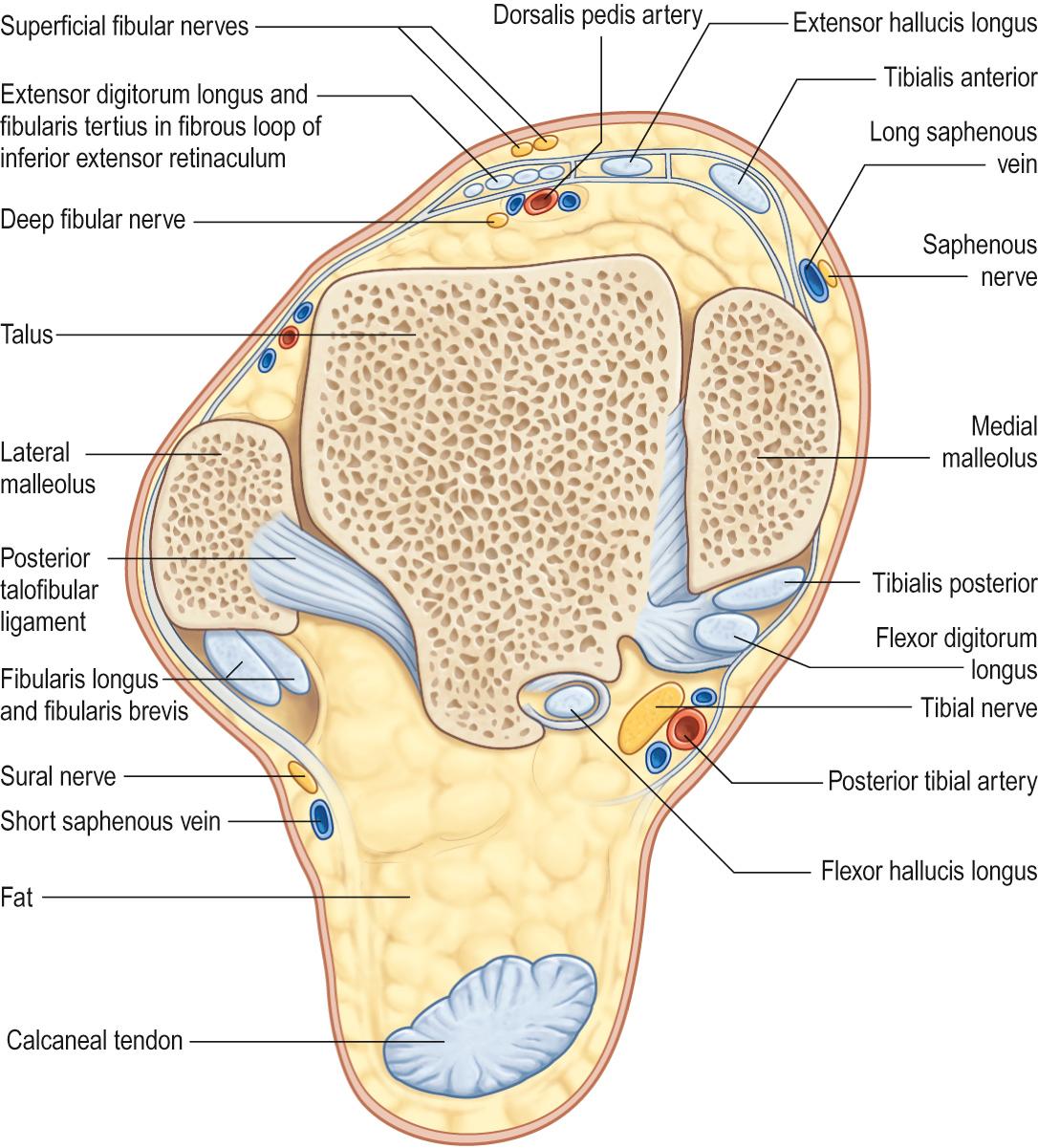
Become a Clinical Tree membership for Full access and enjoy Unlimited articles
If you are a member. Log in here